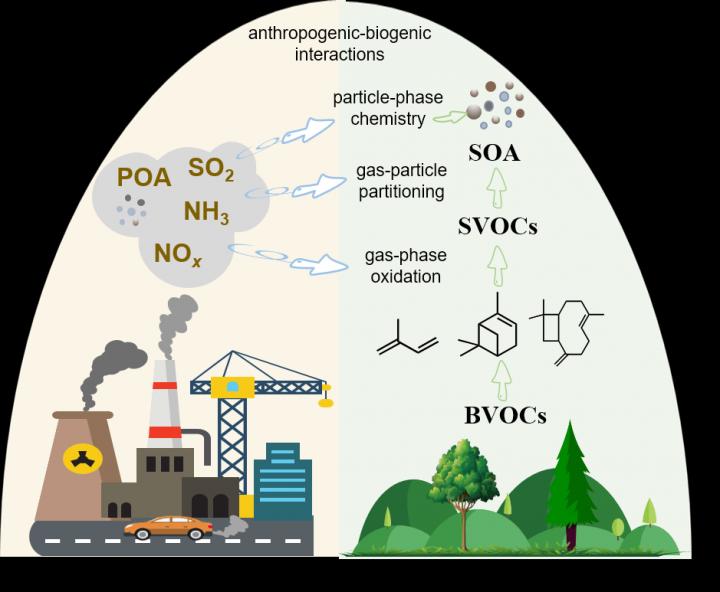
Credit: Li Xu
Despite their extremely small size, submicron atmospheric aerosols are critical pollutants with climate change, air quality, and human health implications. Of these particles, secondary organic aerosols (SOA) form when volatile organic compounds (VOCs) oxidize to lower volatility products that bond with and increase aerosol particle size, or in some cases, they may simply exist by themselves. SOA constitutes a significant fraction of the global aerosol mass. Scientists are attempting to improve future aerosol modeling, but several discrepancies still exist between model-simulated and field-observed SOA budgets.
”Large uncertainties in model assessments of SOA budgets and correspondingly, its climate effects, motivated extensive research to find out why these exist.” said Prof. Lin Du from the Environmental Research Institute, Shandong University. ”Biogenic volatile organic compounds (BVOCs) produced by terrestrial vegetation are globally major SOA precursors, and their SOA formation potential can be modified by anthropogenic emissions.”
Prof. Du’s research group systematically summarized the field evidence and chemical processes behind SOA formation through anthropogenic-biogenic interactions. Advances in Atmospheric Sciences published their review work titled ”Anthropogenic Effects on Biogenic Secondary Organic Aerosol Formation.”
The predominant anthropogenic pollutants, including nitrogen oxides (NOx), aerosol particles, sulfur dioxide (SO2), ammonia (NH3), and other amines mediate SOA formation through both gas- and particle-phase reactions. The extent of these interactions is highly related to the BVOC precursors, pollutant levels, oxidants, and other atmospheric conditions.
”The nonlinear interactions between human and natural systems are far more complex than their current representation in atmospheric models.” said Prof. Du. “Meanwhile, the complexity and variability of the atmospheric environment itself makes the exploration of these interactions more challenging.”
Researchers have observed strong correlations between biogenic SOA formation and anthropogenic pollutants in many regions influenced by both anthropogenic and biogenic sources. Though BVOCs emitted from natural sources cannot be controlled directly, humans can mitigate a fraction of biogenic SOA by limiting anthropogenic pollutants. Shedding light on anthropogenic-biogenic interactions is necessary to improve estimates of how and to what extent anthropogenic emissions could modify global aerosol concentrations. These studies should help shape more effective pollution control measures as well as reduce uncertainties in the SOA budget and its associated climate effects.
”Based on comprehensive review of fundamental insights, future efforts, such as laboratory studies under more relevant atmospheric conditions, development of more authentic standards, field observations of the temporal and spatial distribution of both BVOCs, and anthropogenic pollutants, are recommended.” said Prof. Du. “With increasing studies on the qualitative and quantitative analysis of anthropogenic-biogenic interactions through laboratory explorations and field observations, better reproduction of SOA concentrations by atmospheric models would be expected.”
###
Media Contact
Ms. Zheng Lin
[email protected]
Related Journal Article
http://dx.




